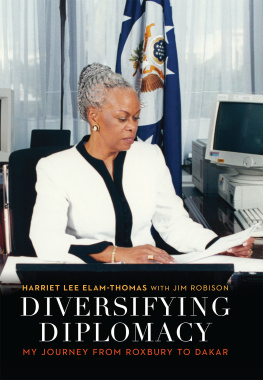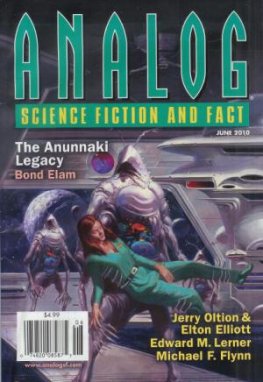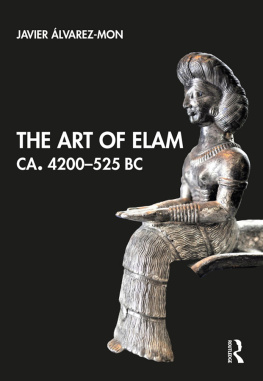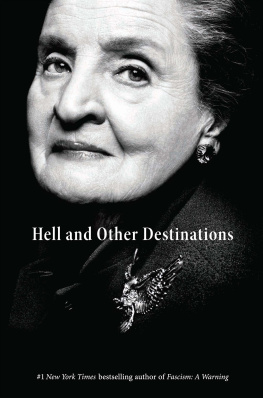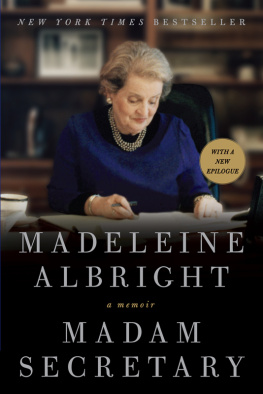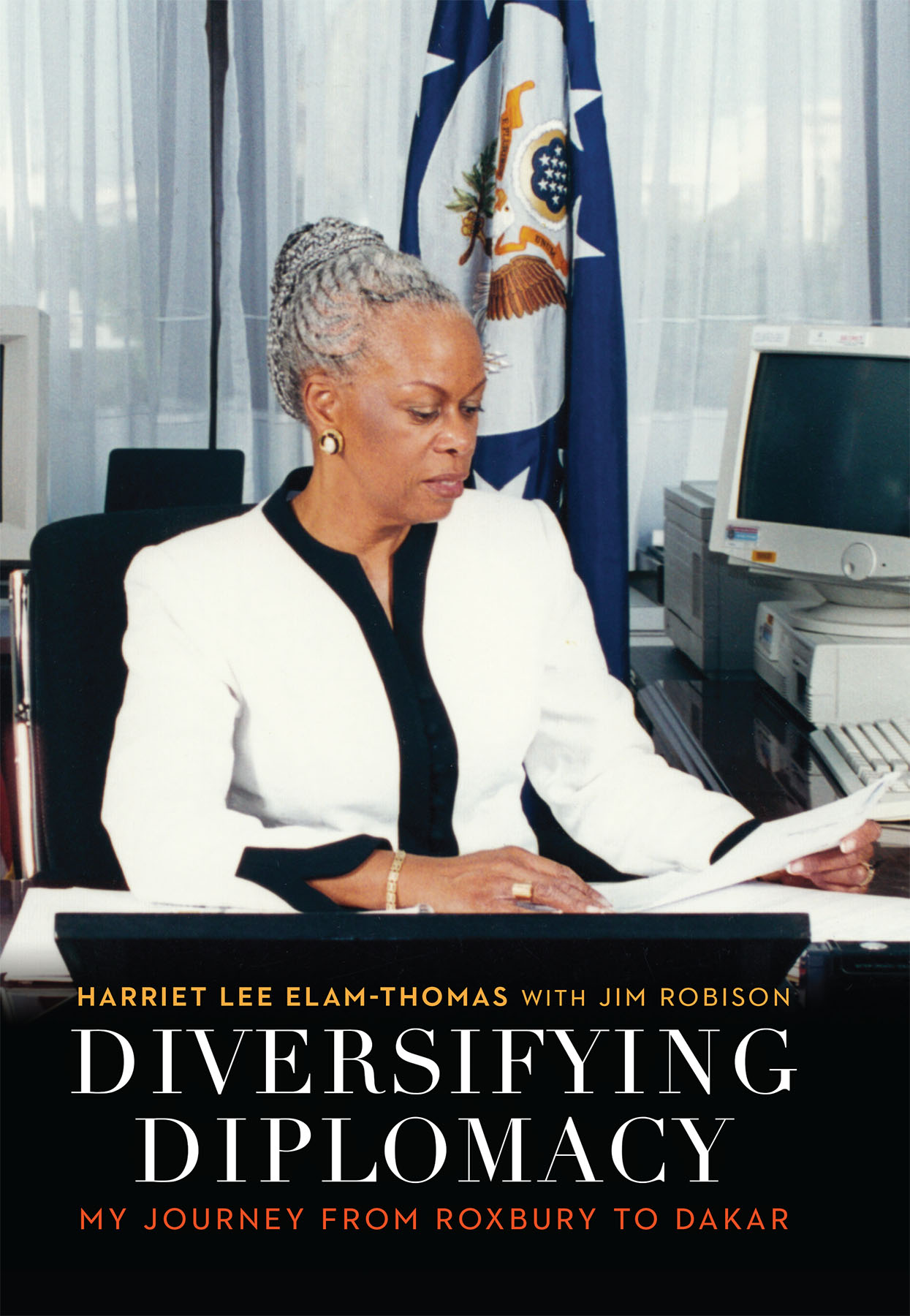
Diversifying Diplomacy, the memoir of Harriet Elam-Thomas, is more than just a personal history, more than just a her-story. It is the timely narrative of an African American woman weaned in black Boston on family pride and ambition, liberated through education, inspired by civil rights battles, and mentored to the top by fellow travelers and battle-scarred elders. Hers is a great American story. It is fact, not fiction. Its real.
Milton Coleman, retired senior editor of the Washington Post
Harriet Lee Elam-Thomass insights and inside stories from the State Department and her postings in Europe, the Middle East, and Africa make it clear that foreign relations is a tough, sensitive, and truly person-to-person undertaking, one that cannot be negotiated in a Twitter feed. This volume is essential for any student of Americas international affairs over the past five decades.
Robert L. Dilenschneider, chairman and founder of the Dilenschneider Group, Inc., and author of Power and Influence and On Power
A prime resource for anyone seeking a better understanding of modern American diplomacy and its historical underpinnings. Rich with insights into the U.S. State Department, the Foreign Service in particular, and the governments foreign-policy apparatus, this memoir reads easily and compellingly. Readers will learn, through Harriet Elam-Thomass eyes, how U.S. foreign policy and diplomacy evolved over the past four decades.
Gen. James L. Jones, USMC (Ret.), former national security advisor and former supreme Allied commander Europe and combatant commander USEUCOM
This captivating, inspiring memoir breathes life into the American dream, recounting Elam-Thomass exciting, improbable rise through the diplomatic ranks using the arts as a diplomatic tool while proving the value of cultural competency and diversity in U.S. foreign policy.
Ambassador Ruth A. Davis (Ret.)
Featuring lively portrayals of diverse people and places, this clearly written memoir describes success in meeting the challenges of race and gender during forty-two years in the Foreign Service. The importance of family support that nurtured sustaining personal beliefs is highlighted along with other significant human relationships and career experiences turned into positive opportunities to grow and learn.
Vivian R. Johnson, associate professor of education emerita at Boston University
Ambassador Harriet Elam-Thomas, always self-assured and humble, has made a definitive and tangible difference in the world. This thoroughly engaging read reveals how the convergence of empathy, compassion, persuasion, and diversifying diplomacy can make us all contributors to our global story.
Carmen J . Smith, vice president of creative development and inclusive strategies at Walt Disney Imagineering
Diversifying Diplomacy
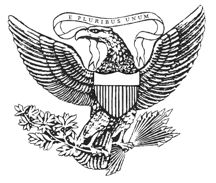
ADST-DACOR Diplomats and Diplomacy Series
Series Editor
Margery Boichel Thompson
Since 1776, extraordinary men and women have represented the United States abroad under widely varying circumstances. What they did and how and why they did it remain little known to their compatriots. In 1995, the Association for Diplomatic Studies and Training ( ADST ) and DACOR , an organization of foreign affairs professionals, created the Diplomats and Diplomacy book series to increase public knowledge and appreciation of the professionalism of American diplomats and their involvement in world history. The story of Harriet Elam-Thomass trajectory from growing up in the Roxbury section of Boston to heading the U.S. embassy in Dakar, Senegal, is the sixty-second volume in the series.
Diversifying Diplomacy
My Journey from Roxbury to Dakar
Harriet Lee Elam-Thomas with Jim Robison
Foreword by Allan E. Goodman | Preface by John C. Bersia
Potomac Books | An imprint of the University of Nebraska Press
An ADST-DACOR Diplomats and Diplomacy Book
2017 by Harriet Lee Elam-Thomas. The opinions and characterizations in this book are those of the author and do not necessarily represent official positions of the U.S. government, the Association for Diplomatic Studies and Training DACOR , or the University of Central Florida.
Cover designed by University of Nebraska Press; cover image is from the interior.
Author photo Wilfred J. Thomas.
All rights reserved. Potomac Books is an imprint of the University of Nebraska Press.
Publication of this volume was made possible in part by the generous support of the H. Lee and Carol Gendler Charitable Fund.
Library of Congress Cataloging-in-Publication Data
Names: Elam-Thomas, Harriet Lee, 1941 author. Robison, Jim, 1952 author.
Title: Diversifying diplomacy: my journey from Roxbury to Dakar / Harriet Lee Elam-Thomas with Jim Robison; foreword by Allan Goodman; preface by John Bersia.
Description: Lincoln, Nebraska: Potomac Books, 2017. Series: ADST - DACOR diplomats and diplomacy series Includes index.
Identifiers: LCCN 2017026737 (print)
LCCN 2017044326 (ebook)
ISBN 9781612349800 (epub)
ISBN 9781612349817 (mobi)
ISBN 9781612349824 (pdf)
ISBN 9781612349503 (hardback: alk. paper)
Subjects: LCSH : Elam-Thomas, Harriet Lee, 1941 | DiplomatsUnited StatesBiography. | Women diplomatsUnited StatesBiography. | African American diplomatsBiography. | United StatesForeign relationsSenegal. | SenegalForeign relationsUnited States. | United StatesForeign relations1989 | BISAC : BIOGRAPHY & AUTOBIOGRAPHY / Women. | BIOGRAPHY & AUTOBIOGRAPHY / Political. | POLITICAL SCIENCE / International Relations / Diplomacy.
Classification: LCC E 840.8. E 43 (ebook) | LCC E 840.8. E 43 A 3 2017 (print) | DDC 327.2092 [B]dc23
LC record available at https://lccn.loc.gov/2017026737
The publisher does not have any control over and does not assume any responsibility for author or third-party websites or their content.
Contents
Allan E. Goodman
You really need to interview her. This advice from the head of the U.S. Information Agencys ( USIA ) Equal Employment Opportunity Office made it clear that Harriet Elam had succeeded. She was in line to become the senior-most Foreign Service officer at the agency. She would soon be its counselor. And, many said, an ambassadorship would be next.
I was struck initially by the character of her office. It was grand as government offices go and clearly thought out. A visitor would see the traces of service abroad, commendations, and above all, that it was just neat and proper. What Harriet did not know is that the head of personnel had just given me a tour of the old USIA /Voice of America headquarters. The Wilbur J. Cohen Building had been constructed in 1940 and contained some famous Ben Shahn murals, depicting the era of the New Deal.
But my attention was directed to two water fountains. A few feet separated them. Remember, I was told, the U.S. government used to be segregated. It started with Woodrow Wilson. We had separate bathrooms and still have these separate fountains. I found their continued existence, this particular lesson in history, strange.
Harriet would give me another, more pleasant lesson that day when I made a casual remark about how elegant her office appeared. I expected she would give me the tour of where she had been for each of the pictures and artifacts displayed. Instead, she said what made the office nice for her and others on the executive floor was how hard the cleaning staff worked to keep things clean. We all work pretty late into the evening. And only when we go home do the cleaners get to start their work. It isnt easy, and I am grateful to them every morning I come back in.

